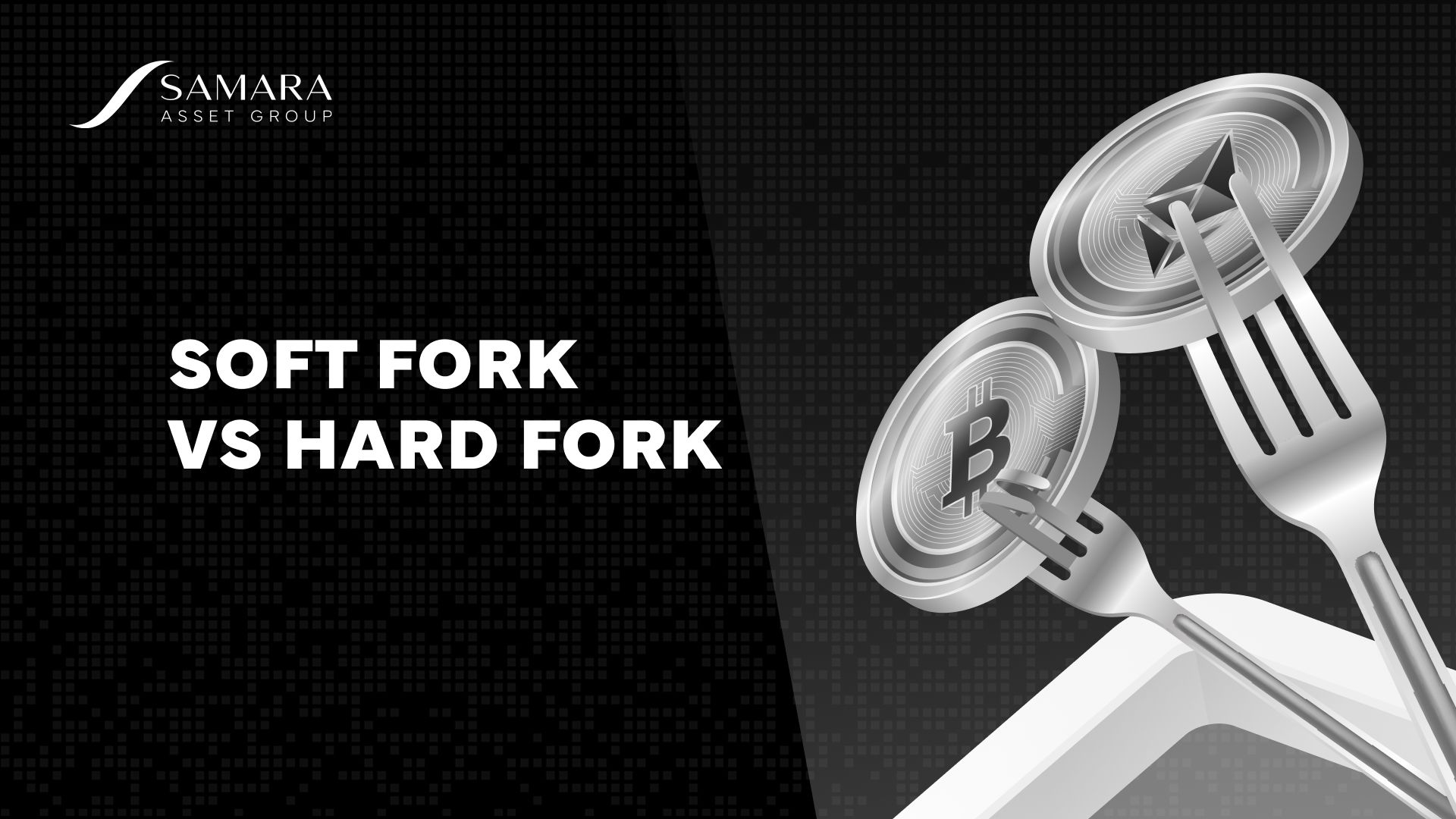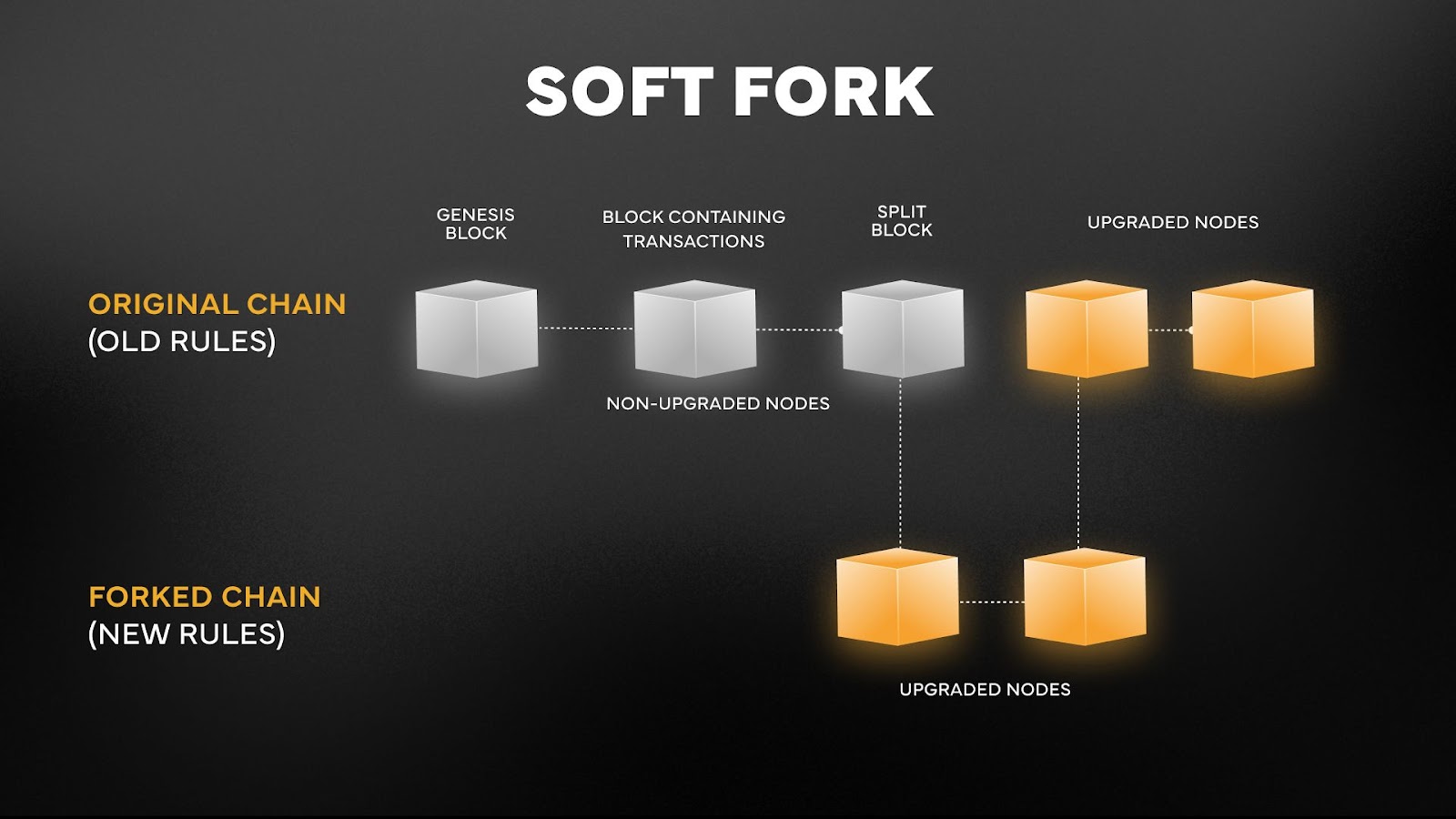Bitcoin
Bitcoin CPI
Venture Portfolio
Funds
Market Insights
Indicators
About
Contact

February 12, 2025





Soft and hard forks are two important concepts in blockchain. They describe how a blockchain is upgraded or a new chain is created.
In this guide, we’ll explain what soft and hard forks are, how they differ, what examples of important Bitcoin forks are, and whether they have been successful.
A soft fork is a backward-compatible upgrade to a blockchain protocol. This allows for the introduction of updates while keeping the main rules of the original chain unchanged.

Soft forks can help scale a blockchain, make it safer, or introduce other upgrades that improve the network one way or another. As soft forks are backward-compatible, blockchain node runners can still use the previous version of the protocol and be able to participate in the network.
However, if they want to use all the benefits of new features, node owners would need to upgrade their node software.
Important Bitcoin upgrades such as SegWit (Segregated Witness) and Taproot were introduced as soft forks, helping the network scale, making it more private, or enabling innovations on this blockchain, such as the Lightning Network and Ordinals. In either case, older Bitcoin nodes are still able to participate in the network by following pre-soft fork protocol rules.
A hard fork is an upgrade to a blockchain protocol that fundamentally changes the network as a new chain is created.

Hard forks are used to create a new version of the original blockchain. It can be done for two main reasons: to introduce a fundamental change to the protocol or to create a competing chain.
In the former case, the original chain usually stops being updated and all the activity moves to the new one. In case a hard fork is attempting to create a competing chain, both chains can grow separately, allowing the market to decide which is better.
Via hard forks, a new token can be introduced, consensus rules might be changed, or a user might decide to backroll transactions on the original chain.
Bitcoin saw multiple hard forks as various teams attempted to create “a better version of Bitcoin,” forking the Bitcoin blockchain and introducing changes to the protocol.
The most prominent example is the Bitcoin Cash (BCH) hard fork in 2017, which introduced 32 MB blocks on this chain (Bitcoin’s block size now is effectively 4 MB). Another example was the Ethereum (ETH) hard fork in 2016, which was implemented to return stolen funds after the DAO hack.
Soft and hard forks have a similar approach.
In both cases, a change in the protocol is proposed, carefully discussed, and later voted upon. If the vote passes, the fork is scheduled at a particular block height. This is known as the split block, after which the changes come into effect.
The difference, however, is in the implementation of these upgrades.
In the case of Bitcoin, soft forks require a majority of the network's miners to agree to the change. Node runners can enable the change if there is a majority agreement. Because soft forks are backward compatible, there are no issues verifying transactions.
Hard forks, on the other hand, need all node runners and a majority of the miners to agree to the change and execute the chain split.
Hard forks create an entirely new version of the original blockchain, sometimes with a new token and different protocol or consensus rules. On the other hand, soft forks are more like upgrades to the existing infrastructure.
There are several key differences between soft and hard forks:

In addition to technical risks, hard forks can introduce a risk of division within the blockchain’s community if the implemented change is controversial. Moreover, every node in the network must agree to the new protocol changes – one node runner not agreeing to the change can further delay the upgrade.
There are several examples of soft and hard forks in Bitcoin, which have significantly impacted the history of the largest cryptocurrency:
Occuring in August of 2017, the Segregated Witness (SegWit) soft fork helped increase Bitcoin block capacity, which now effectively stands at 4 MB, by removing the witness signatures from the transaction section. This has made the blockchain more efficient with faster and potentially cheaper transactions. This soft fork also laid the groundwork for the most popular Bitcoin Layer 2 scaling solution, Lightning Network.
The SegWit upgrade was implemented after the so-called Bitcoin Blocksize War, which resulted in the Bitcoin Cash hard fork on the same day.
Bitcoin Cash (BCH) is one of the first hard forks in Bitcoin history and remains the most popular. The idea behind this fork was to increase the block size to 32 MB and enable more peer-to-peer transactions on the blockchain.
After the fork, BTC holders received an equivalent amount of the newly created cryptocurrency, BCH. Despite its initial success, this network dropped in the rankings and is now the 25th largest crypto asset by market capitalization. After reaching its all-time high of around $3,786 in December 2017, it is down almost 90%.
Occurring in November 2021, Taproot is the most recent Bitcoin soft fork. It helped to increase Bitcoin's efficiency and privacy even further, once again helping to make transactions cheaper.
While initially slow, the adoption of this upgrade accelerated in 2023, when the Taproot-enabled Ordinals protocol was introduced, beginning a new era of inscriptions and both non-fungible and fungible tokens on the Bitcoin blockchain.
While Bitcoin maintains its position at the top of the digital asset market, initiatives such as Bitcoin Cash, Bitcoin SV (BSV), and others have tried to emulate Bitcoin’s success and build an improved version.
However, all of them failed to do so.
There are a few reasons as to why this happened. One of the main reasons is market trust. While there was always enthusiasm at the beginning of each hard fork, what quickly followed was disappointment and a lack of developer support.
The promises of better scalability, increased adoption among institutional investors, and outperformance compared to BTC were never fulfilled. Such distrust quickly led to new price lows and a vast number of investors and participants leaving the new network.
Forks have a significant impact on blockchain development as they help upgrade networks, introduce new features, and make transactions cheaper and faster.
Hard forks that require a chain split are used for complicated tasks, such as changing consensus rules or, in some cases, rolling back previous transactions, as it infamously happened after the DAO hack at the beginning of Ethereum history.
However, soft forks can introduce important upgrades, as is evident in Bitcoin, where the SegWit soft fork enabled scaling solutions such as the Lightning Network, while Taproot helped introduce Ordinals.
Soft forks maintain backward compatibility through a clever mechanism, as new rules are added as a subset of the old rules. This is why blocks and transactions can be mostly valid under both new and old rules. Also, node runners can choose which protocol version they want to run while still being able to participate in the network.
Yes, a blockchain can survive multiple hard forks. However, the success depends on key factors, such as network support, economic viability, technological implementations of the new rules, resource distribution amongst miners and node runners, and community consensus.
Yes, soft forks are considered safer than hard forks because they maintain backward compatibility and ensure the participation of all participants in the network. They also allow all stakeholders to adapt to the new rules gradually.